Lawn Weed Identification and Control Tips
How to identify and manage Common Chickweed Stellaria media (sometimes called Starwort). Photos are included to help with weed ID.
Chickweed is a creeping winter annual lawn weed. Seeds germinate in fall or late winter. Its spreading branches take root where they contact the soil, allowing it to completely overgrow large patches of lawns.
Characteristics:
- Winter annual
- Reproduces by seed and through the fibrous root system
- Creeping growth habit
- Small, pale green leaves
- Hairy stems
- White star-like flowers
- Indicates moist, compacted soils
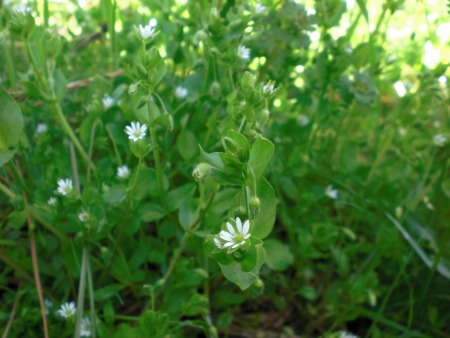
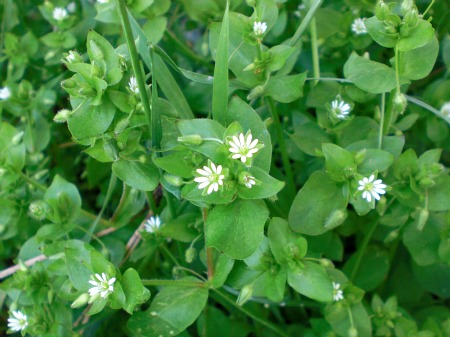
The best weed control is always a healthy, well-managed lawn that will not allow weed seeds to germinate and grow. Weed seeds need contact with soil and sunlight to germinate and grow into mature weeds. A dense, vigorous lawn will choke out weed seedlings before they become established.
Want to know what your lawn needs and when to apply it?
Let the turfgrass experts on Sunday take care of the technical stuff.
Have you heard about the Sunday Smart Lawn Plan? It’s simple, do-it-yourself natural lawn care that’s customized to your soil, climate, and lawn. Delivered to you right when you need it. You apply the nutrient packets with the included hose-end sprayer…simple, professional results!
Sunday’s plant and soil nutrient products are made from food waste, seaweed, and molasses. The natural additives stimulate plant growth and activate soil life.
This is Super Environmentally Friendly lawn care!
Common Chickweed Control in Lawns
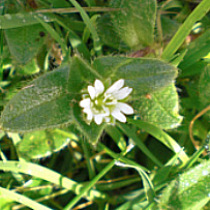
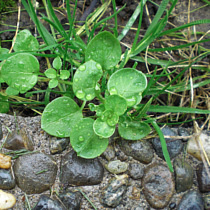
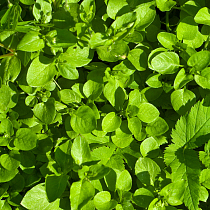
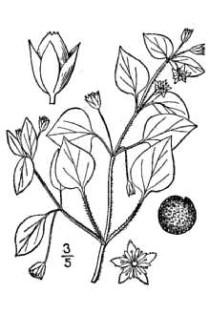
Common Chickweed Stellaria media L.
Image courtesy of USDA-NRCS PLANTS Database
Life cycle – winter annual (cool-season weed) that reproduces by seed. Its life cycle starts in the fall with seed germination, then flowering in the spring, setting seed and dying as the temperatures rise.
Chemical Control – Winter annual weeds complete their life cycle in the spring. So the best time to control them with chemicals is in the fall.
Lawn Weed Identification and Control Tips
How to identify and manage Common Chickweed Stellaria media (sometimes called Starwort). Photos are included to help with weed ID.
Chickweed is a creeping winter annual lawn weed. Seeds germinate in fall or late winter. Its spreading branches take root where they contact the soil, allowing it to completely overgrow large patches of lawns.
Characteristics:
- Winter annual
- Reproduces by seed and through the fibrous root system
- Creeping growth habit
- Small, pale green leaves
- Hairy stems
- White star-like flowers
- Indicates moist, compacted soils


The best weed control is always a healthy, well-managed lawn that will not allow weed seeds to germinate and grow. Weed seeds need contact with soil and sunlight to germinate and grow into mature weeds. A dense, vigorous lawn will choke out weed seedlings before they become established.
Want to know what your lawn needs and when to apply it?
Let the turfgrass experts on Sunday take care of the technical stuff.
Have you heard about the Sunday Smart Lawn Plan? It’s simple, do-it-yourself natural lawn care that’s customized to your soil, climate, and lawn. Delivered to you right when you need it. You apply the nutrient packets with the included hose-end sprayer…simple, professional results!
Sunday’s plant and soil nutrient products are made from food waste, seaweed, and molasses. The natural additives stimulate plant growth and activate soil life.
This is Super Environmentally Friendly lawn care!
Common Chickweed Control in Lawns




Common Chickweed Stellaria media L.
Image courtesy of USDA-NRCS PLANTS Database
Life cycle – winter annual (cool-season weed) that reproduces by seed. Its life cycle starts in the fall with seed germination, then flowering in the spring, setting seed and dying as the temperatures rise.
Chemical Control – Winter annual weeds complete their life cycle in the spring. So the best time to control them with chemicals is in the fall.
**Be sure to read and follow the directions on the label if you choose to use an herbicide. It is a violation of federal law to use ANY pesticide in a manner that is not consistent with the label**
You can use a pre-emergent herbicide – commonly called ‘crabgrass preventer’ – if you are not planting new grass seed in the fall. Be sure to apply it in early fall before the weather turns cool and weed seeds germinate. Another option is to use a post-emergent broad-leaf herbicide. Post-emergent herbicides work best on young, small weeds
Post-emergent herbicides labeled for chickweed control in residential lawns
Landscape beds can be spot sprayed with glyphosate (Roundup), a non-selective post-emergent weed spray. Avoid damage to non-target plants from over-spray or drift.
Hand Weeding – pull or dig, be sure to remove the entire plant and root.
Weed Identification
Leaves – The light green leaves are arranged opposite along the stem. They are from 1/2″ to 1 1/4″ long. The upper leaves do not have a petiole, the lower leaves have a long petiole.
Stems – The creeping stem spread along the ground and root at the nodes. Stems are light green and hairy. The hairs run in vertical rows along the stem.
Roots – Shallow, fibrous root system.
Flowers – Tiny (5 to 10 mm) white star-like flowers. The flowers look like they have 10 petals. Take a close look and you will see five deeply lobed petals.
Growth Habit – Creeping, spreading habit that forms mats. It grows to about 12 inches tall.
It can be found in lawns and gardens throughout the United States. It prefers moist soils that are high in nitrogen.
According to the U.S. Forest Service, “reported invasive in HI, KY, MD, NC, NJ, PA, TN, VA, and WV.”
You might like these weed identification and control tips:
Corn Speedwell | Veronica Arvensis | Lawn Weed Identification
Corn Speedwell (Veronica arvensis) is a low-growing winter annual and a common weed problem in thin turf stands and newly seeded lawns. Pictures to help with lawn weed identification and control.
Mouse-Ear Chickweed | Lawn Weed ID & Control
Mouse-ear chickweed is a common lawn weed found throughout the United States. Its characteristics make it a competitive weed in lawns.
Henbit | Lawn Weed Identification & Control Tips
How to identify and manage Henbit (Lamium amplexicaule) a common lawn weed that resembles ground ivy. Purple to pink tubular-shaped flowers that bloom in the spring. Photos are included to help
**Be sure to read and follow the directions on the label if you choose to use an herbicide. It is a violation of federal law to use ANY pesticide in a manner that is not consistent with the label**
You can use a pre-emergent herbicide – commonly called ‘crabgrass preventer’ – if you are not planting new grass seed in the fall. Be sure to apply it in early fall before the weather turns cool and weed seeds germinate. Another option is to use a post-emergent broadleaf herbicide. Post-emergent herbicides work best on young, small weeds
Post-emergent herbicides labeled for chickweed control in residential lawns
Landscape beds can be spot sprayed with glyphosate (Roundup), a non-selective post-emergent weed spray. Avoid damage to non-target plants from over-spray or drift.
Hand Weeding – pull or dig, be sure to remove the entire plant and root.
Weed Identification
Leaves – The light green leaves are arranged opposite along the stem. They are from 1/2″ to 1 1/4″ long. The upper leaves do not have a petiole, the lower leaves have a long petiole.
Stems – The creeping stem spread along the ground and root at the nodes. Stems are light green and hairy. The hairs run in vertical rows along the stem.
Roots – Shallow, fibrous root system.
Flowers – Tiny (5 to 10 mm) white star-like flowers. The flowers look like they have 10 petals. Take a close look and you will see five deeply lobed petals.
Growth Habit – Creeping, spreading habit that forms mats. It grows to about 12 inches tall.
It can be found in lawns and gardens throughout the United States. It prefers moist soils that are high in nitrogen.
According to the U.S. Forest Service, “reported invasive in HI, KY, MD, NC, NJ, PA, TN, VA, and WV.”
You might like these weed identification and control tips:
Corn Speedwell | Veronica arvensis | Lawn Weed Identification
Corn Speedwell (Veronica arvensis) is a low-growing winter annual and a common weed problem in thin turf stands and newly seeded lawns. Pictures to help with lawn weed identification and control.
Mouse-Ear Chickweed | Lawn Weed ID & Control
Mouse-ear chickweed is a common lawn weed found throughout the United States. Its characteristics make it a competitive weed in lawns.
Henbit | Lawn Weed Identification & Control Tips
How to identify and manage Henbit (Lamium amplexicaule) a common lawn weed that resembles ground ivy. Purple to pink tubular-shaped flowers that bloom in the spring. Photos are included to help.
